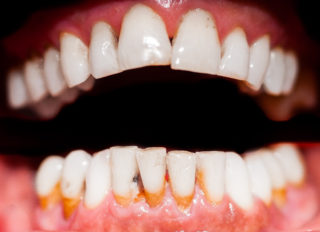
Periodontitis is a bacterial infection that affects periodontal tissues (gums, periodontal ligament and alveolar bone), which are responsible for providing support to the teeth.
Gums will create space and move away from the teeth, allowing bacterial plaque to infiltrate the root, support fibres, and bone. In advanced periodontitis, support fibres and bone are destroyed. There is high tooth mobility and most of the times, an extraction will be necessary.
Symptoms:
- Bad breath (halitosis);
- Sensitivity to cold;
- Dental positioning changes;
- Formation of pus (suppuration);
- Spontaneous gum bleeding;
- Bleeding while brushing;
- Dental mobility;
- Red and swollen gum;
- Teeth with no gum;
- Receding gums;
What is gum disease?
It is an inflammation that can affect teeth support—in other words, the maxillary bone or mandible. The destruction of this support will cause periodontal pockets. Gum inflammation is caused by bacteria living in the mouth, which over time will create a film. This film can harden and, in order to prevent that from happening, it is important to brush your teeth daily or you might not be able to remove it. This film is known as bacterial plaque. Sometimes, when there is a large amount of bacterial plaque, only the dentist will be able to remove it.
What are the consequences of periodontitis?
Periodontitis may cause dental mobility—in other words, the teeth will be movable. If there is high mobility, it means you can lose your teeth because they will have to be removed by the dentist. In extreme cases, when the disease is at an advanced stage, the teeth may fall out naturally.
What are the stages of gum disease?
The first stage consists of bacterial plaque increasing between the teeth and gums. The increase of plaque will cause the gum inflammation also known as gingivitis. When detected early, gingivitis can be treated and is reversible. The irreversible disease stage is known as periodontitis—in other words, support of the teeth and bone is permanently compromised. Every now and then, an invisible pocket will be formed under the gums where there is a build-up of food remains and bacterial plaque.
How do I know if I have gum disease?
The first sign includes gums that bleed while brushing. Other signs are swollen or reddish gums. Gums may shrink and teeth will look longer than usual. It may also create gaps between teeth and pus. Persistent bad breath and a constant bad taste in the mouth are warning signals.
How are periodontitis and gingivitis treated?
- Effectively brushing your teeth will help to remove bacterial plaque and prevent its calcification.
- An effective Scaling and Root Planing will remove bacterial plaque even when is already transformed into tartar or is calcified. Scaling and Root Planing is performed with a device that emits vibrations and is called scaler.
- Root planing is also an alternative gum treatment. This will scale the tooth root. With careful scaling, the dentist will scale and clean irregular areas of the tooth root and periodontal pockets. This procedure prevents bacterial plaque and tartar from building up in that area again. It can be carried out manually or with ultrasound devices.
- Using surgery to remove periodontal pockets is another procedure to treat periodontitis. The gum tissue is detached for plaque removal and then placed back again with stitches. It is a procedure carried out in the dental office with local anaesthesia and the post-surgery is simple and painless.
VitaCentre Medical Reference- Reviewed by VitaCentre Dental Clinic Staff on June 12, 2022

